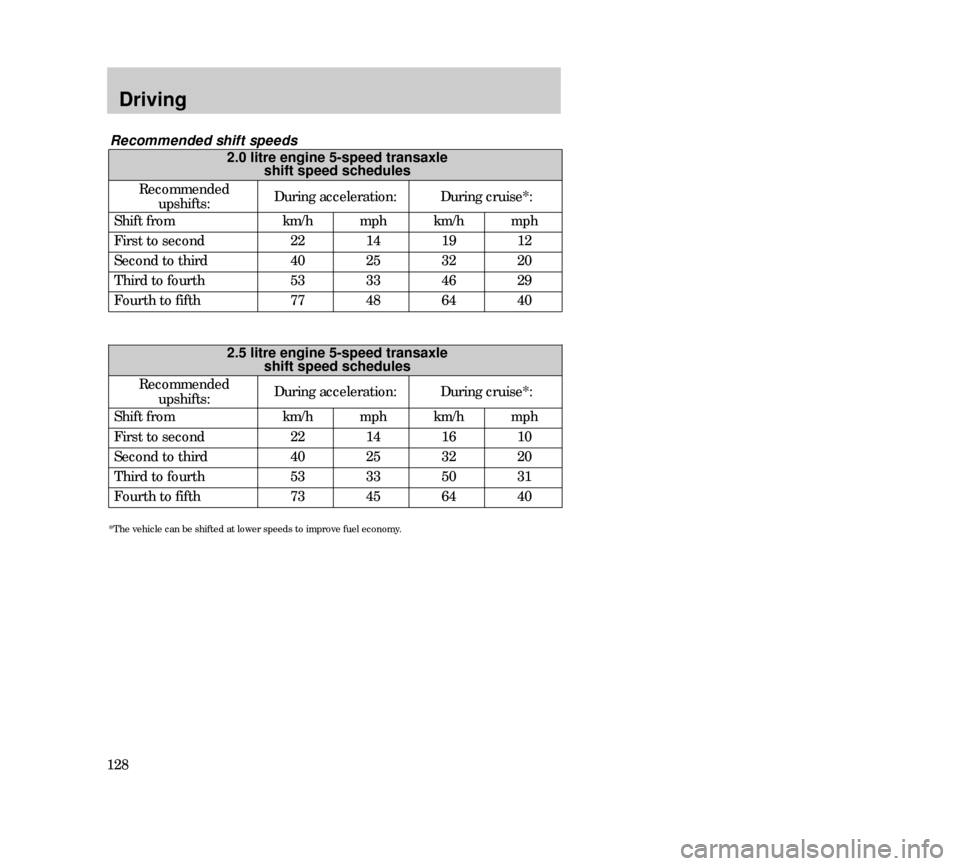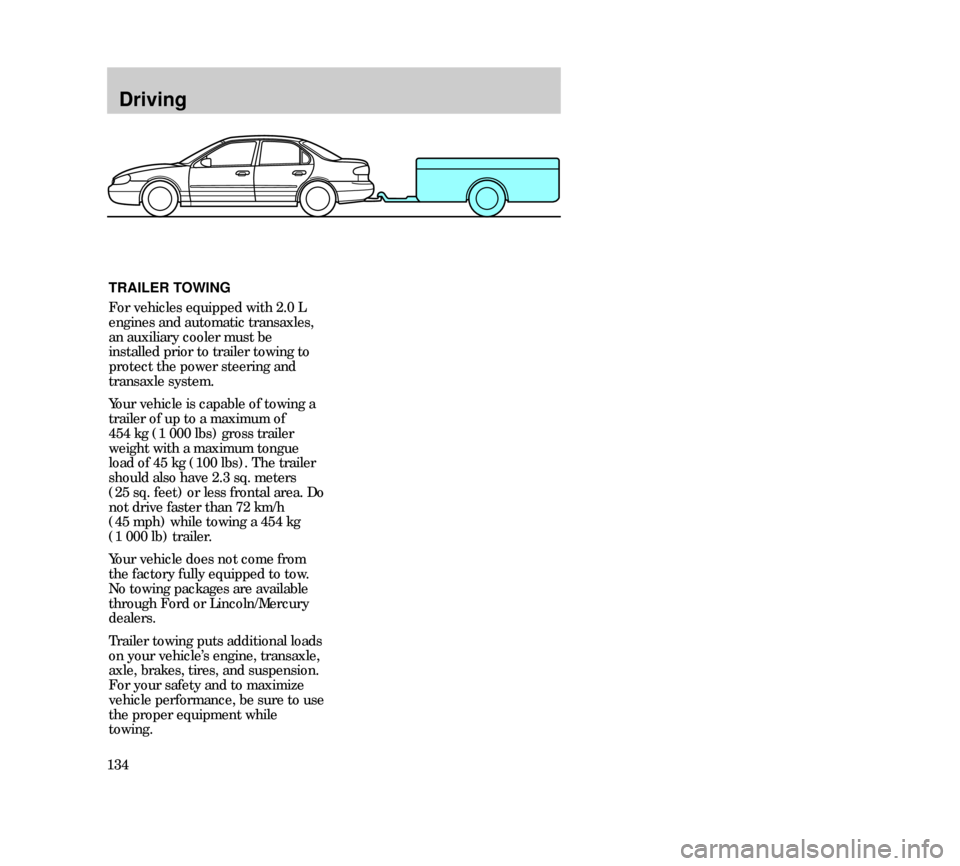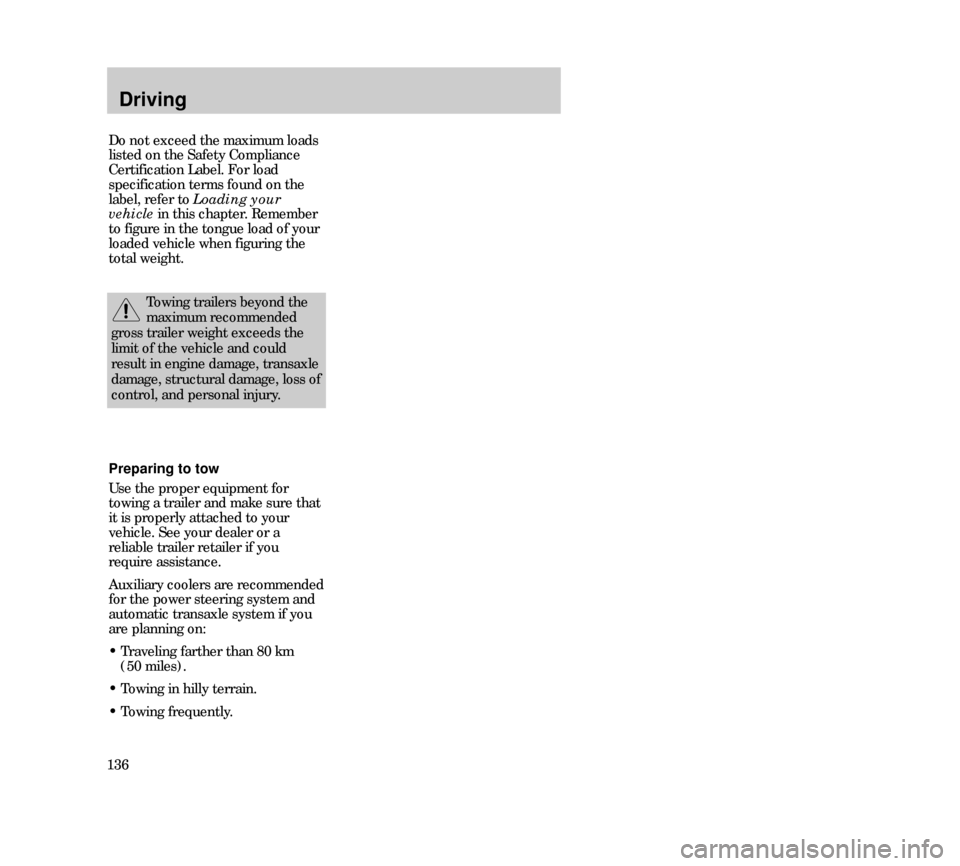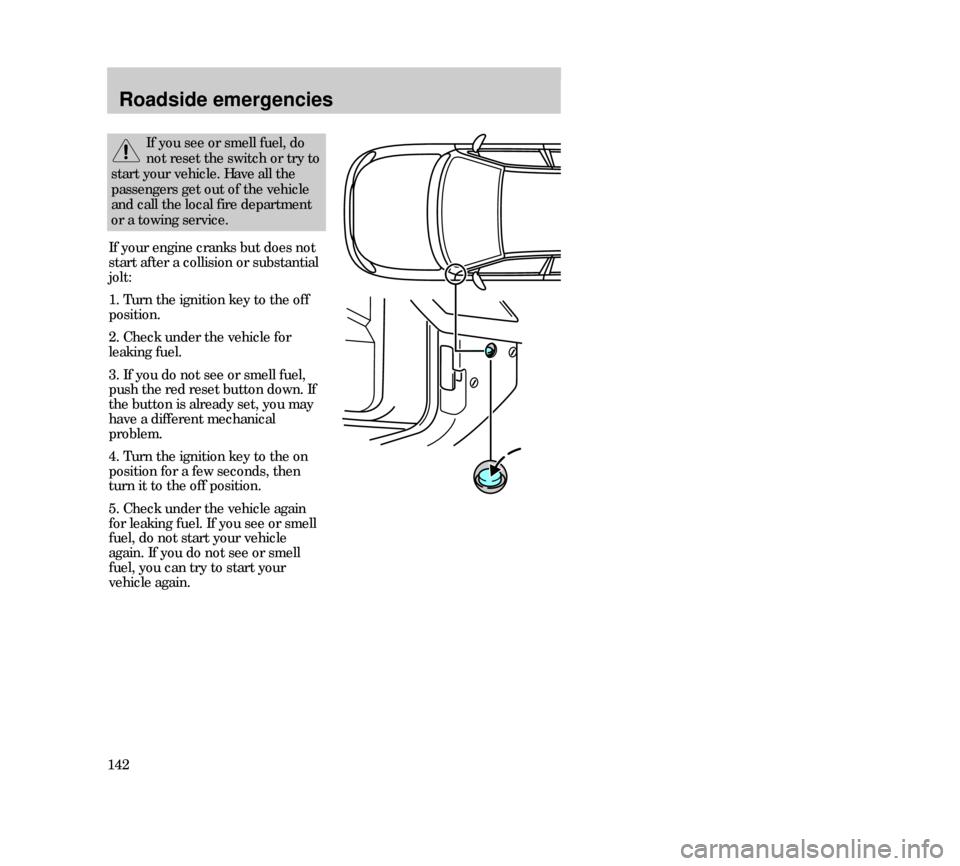engine Mercury Mystique 2000 s Service Manual
[x] Cancel search | Manufacturer: MERCURY, Model Year: 2000, Model line: Mystique, Model: Mercury Mystique 2000Pages: 248, PDF Size: 2.2 MB
Page 127 of 248

Driving
127 Manual transaxle (if equipped)
Vehicles equipped with a manual
transaxle have a starter interlock
that prevents cranking the engine
unless the clutch pedal is fully
depressed.
Using the clutch
When starting a vehicle with a
manual transaxle:
1. Hold down the brake pedal.
2. Depress the clutch pedal.
3. Put the gearshift lever in neutral.
4. Start the vehicle.
5. Put the gearshift in 1 (First) or R
(Reverse).
6. Release the clutch slowly while
pressing gradually down on the
accelerator pedal.
Do not drive with your foot resting
on the clutch pedal. Do not use the
clutch to hold your vehicle at a
standstill while waiting on a hill.
These actions may reduce the
clutch life.
22MDren 24.6.99 15:26 Uhr Seite 127
Page 128 of 248

Driving
128
*The vehicle can be shifted at lower speeds to improve fuel economy.
22 Recommended shift speeds
2.0 litre engine 5-speed transaxle
shift speed schedules
Recommended
upshifts:
Shift from km/h mph
14
25
33
48
40
53
77mph
12
20
29
40
km/h
19
32
64 First to second
Second to third
Third to fourth
Fourth to fifth
During acceleration:During cruise*:
46
2.5 litre engine 5-speed transaxle
shift speed schedules
km/h
mphkm/hmph
10
20
31
40
16
32
50
64
14
25
33
45
22
40
53
73
Shift from
First to second
Second to third
Third to fourth
Fourth to fifthRecommended
upshifts:During acceleration:
During cruise*:
22MDren 24.6.99 15:26 Uhr Seite 128
Page 132 of 248

Driving
132
-9%
-6%
-3% 900 m
(3000 ft)
600 m
(2000 ft)
300 m
(1000 ft)
0 Payload = GVWR minus Base
curb weight
To obtain the correct weight for
your vehicle, try taking your
vehicle to a shipping company or
an inspection station for trucks.
Do not use replacement tires with
lower weight capacities than the
originals because they might lower
the vehicle’s GVWR and GAWR.
(Replacement tires with a higher
weight limit than the originals do
not increase the GVWR and GAWR
limitations.)
In high altitudes, engines will lose
power at a rate of 3% power per
300 m (1 000 ft) increase in
elevation. A reduction in GVW and
GCW is recommended for
maximum vehicle performance.
Do not exceed the GVWR or
the GAWR specified on the
Safety Compliance Certification
Label.
22MDren 24.6.99 15:26 Uhr Seite 132
Page 134 of 248

Driving
134TRAILER TOWING
For vehicles equipped with 2.0 L
engines and automatic transaxles,
an auxiliary cooler must be
installed prior to trailer towing to
protect the power steering and
transaxle system.
Your vehicle is capable of towing a
trailer of up to a maximum of
454 kg (1 000 lbs) gross trailer
weight with a maximum tongue
load of 45 kg (100 lbs). The trailer
should also have 2.3 sq. meters
(25 sq. feet) or less frontal area. Do
not drive faster than 72 km/h
(45 mph) while towing a 454 kg
(1 000 lb) trailer.
Your vehicle does not come from
the factory fully equipped to tow.
No towing packages are available
through Ford or Lincoln/Mercury
dealers.
Trailer towing puts additional loads
on your vehicle’s engine, transaxle,
axle, brakes, tires, and suspension.
For your safety and to maximize
vehicle performance, be sure to use
the proper equipment while
towing.
22MDren 24.6.99 15:26 Uhr Seite 134
Page 136 of 248

Driving
136Preparing to tow
Use the proper equipment for
towing a trailer and make sure that
it is properly attached to your
vehicle. See your dealer or a
reliable trailer retailer if you
require assistance.
Auxiliary coolers are recommended
for the power steering system and
automatic transaxle system if you
are planning on:
• Traveling farther than 80 km
(50 miles).
• Towing in hilly terrain.
• Towing frequently.
Towing trailers beyond the
maximum recommended
gross trailer weight exceeds the
limit of the vehicle and could
result in engine damage, transaxle
damage, structural damage, loss of
control, and personal injury.
Do not exceed the maximum loads
listed on the Safety Compliance
Certification Label. For load
specification terms found on the
label, refer to Loading your
vehiclein this chapter. Remember
to figure in the tongue load of your
loaded vehicle when figuring the
total weight.
22MDren 24.6.99 15:26 Uhr Seite 136
Page 139 of 248

Driving
139 Driving while towing a trailer
Do not drive faster than 72 km/h
(45 mph) while towing a 454 kg
(1 000 lb) trailer. Do not drive
faster than 72 km/h (45 mph) with
any weight trailer while towing in
hilly terrain or on hot days.
Speed control (if equipped) may
not work properly while towing on
long, steep grades.
If driving with an automatic
transaxle:
• Use D (Drive) or a low gear
rather than D (Overdrive) by
depressing the TCS button on the
underside of the gearshift lever,
while towing up or down steep
inclines.
• Anticipate stops and brake
gradually.
If driving with a manual transaxle:
• Select a gear that avoids jerking
or excessive engine speed.
• Avoid driving excessively in first
or second gear. If you need to drive
excessively in first or second gear,
the trailer may be too big or too
heavily loaded for the vehicle
drivetrain.
• Shift to a lower gear while
towing up or down steep hills.
• Anticipate stops and brake
gradually.
22MDren 24.6.99 15:26 Uhr Seite 139
Page 140 of 248

Driving
140FUEL CONSUMPTION
Fuel economy can be improved by
avoiding:
• lack of regular, scheduled
maintenance,
• excessive speed,
• rapid acceleration,
• driving with the brake pedal
depressed,
• sudden stops,
• extended engine idling,
• use of speed control in hilly
terrain,
• extended use of the air
conditioner, defroster, rear window
defroster and other accessories,
• underinflated tires,
• heavy loads,
• aftermarket add-ons such as
bike, ski or luggage racks, bug
deflectors, etc.
23MREen 24.6.99 15:28 Uhr Seite 140
Page 141 of 248

Roadside emergencies
141 HAZARD FLASHER CONTROL
Use only in an emergency to warn
traffic of vehicle breakdown or
approaching danger. Depress to
activate. Depress again to switch
off. The hazard lights can be
operated when the ignition is off.
Off
ResSet
AccCoast
On
FUEL PUMP SHUT-OFF SWITCH
If the engine cranks, but does not
start or does not start after a
collision, the fuel pump shut-off
switch may have been activated.
The shut-off switch is a device
intended to stop the electric fuel
pump when your vehicle has been
involved in a substantial jolt.
Once the shut-off switch is
activated, you must reset the
switch by hand before you can start
your vehicle. The switch is located
on the side panel in front of the
driver’s side door.
23MREen 24.6.99 15:28 Uhr Seite 141
Page 142 of 248

Roadside emergencies
142
If your engine cranks but does not
start after a collision or substantial
jolt:
1. Turn the ignition key to the off
position.
2. Check under the vehicle for
leaking fuel.
3. If you do not see or smell fuel,
push the red reset button down. If
the button is already set, you may
have a different mechanical
problem.
4. Turn the ignition key to the on
position for a few seconds, then
turn it to the off position.
5. Check under the vehicle again
for leaking fuel. If you see or smell
fuel, do not start your vehicle
again. If you do not see or smell
fuel, you can try to start your
vehicle again.
If you see or smell fuel, do
not reset the switch or try to
start your vehicle. Have all the
passengers get out of the vehicle
and call the local fire department
or a towing service.
23MREen 24.6.99 15:28 Uhr Seite 142
Page 143 of 248

Roadside emergencies
143 Even after a fuse is replaced, it will
continue to blow if the cause of the
overload is not identified and
corrected. If the fuse continues to
blow, have the vehicle’s electrical
system checked by your dealer or a
qualified service technician.
To reset a circuit breaker press the
reset button.
The passenger compartment fuse
panel is located on the driver’s side
under the instrument panel. The
power distribution box is located
on the driver’s side of the engine
compartment.
They contain the main fuses and
the main relays. The circuits
protected are identified by
numbers on the passenger
compartment fuse panel and inside
the cover on the power distribution
box.
FUSES AND RELAYS
If electrical components in the
vehicle are not working, a fuse may
have blown. Blown fuses are
identified by a broken wire. Check
the appropriate fuses before
replacing any electrical
components.
Always replace a fuse with
one that has the specified
amperage rating. Using a fuse with
higher amperage rating can cause
severe wire damage and could
start a fire.
23MREen 24.6.99 15:28 Uhr Seite 143